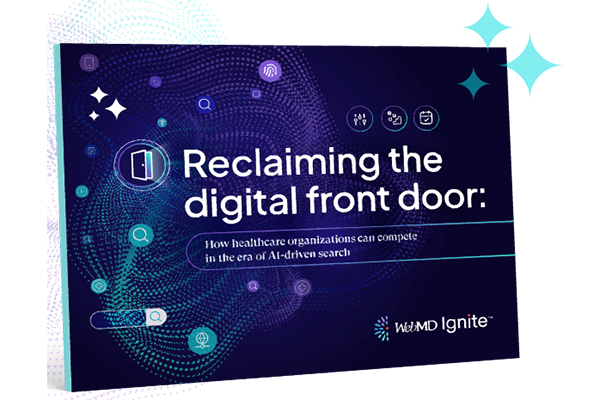Editor's Note: This blog was published prior to the transition to WebMD Ignite.
Ensuring ongoing growth is a necessity for health systems, but in recent years, growth has become a challenge. High-value baby boomers are rapidly aging into Medicare, limiting revenue and forcing health systems to adjust and accelerate their engagement strategies for the next generation. At the same time, health systems are flanked by increasing competition for commercially insured patients from both traditional providers and retail clinics. Continued growth seems difficult to attain.
The situation has forced many health systems to step back and examine new ways to uncover market expansion opportunities. One underleveraged tactic? Using insights into physician referral patterns to influence their approach.
Referral leakage comprises up to 65% of a health system’s lost revenue, so learning how to earn back those referrals is critical for future growth.1 However, changing provider behavior in a meaningful way isn’t easy. It requires an investment in actionable market intelligence and ongoing provider data management through an accurate, up-to-date provider database. Let’s examine why.
The importance of accurate provider data
The provider landscape is complex. Many health systems are tasked with managing multiple locations with hundreds – if not thousands – of employed physicians, specialists, and supporting staff. To compound the challenge, they’re also tracking a swath of affiliated and aligned physicians that are outside of their health system, but are important players in the ecosystem.
Engaging, inspiring loyalty, and keeping up with employed physicians is difficult enough. For physicians outside of your health system, maintaining a two-way line of communication presents its own challenges.
Technology is a must-have. A physician relationship management (PRM) solution enables you to prioritize outreach to employed and affiliated providers, so you can quickly address their issues and identify high-value performers. It also enables line of sight into outreach being performed, and can deliver simple or complex reporting on those activities to your organization. Together, these elements help cultivate meaningful relationships and optimize network utilization.
How PRM encourages sustainable growth
Successful physician relationship management involves business development leaders designing data-driven strategies, and boots on the ground building relationships, delivering promotional messaging and collateral, and resolving issues. Each team relies on the PRM solution for different intelligence. Business development leaders use dashboards and reports to monitor the impact of physician activity, including leakage patterns, across the system. Liaisons identify which physicians need their attention so they can prioritize their activities, and document their visits over time.
By giving these and other stakeholders visibility into provider trends, your health system benefits in the long term. Let’s take a closer look at how this works.
Identify opportunities at the provider level
Did you know engaged physicians are 26% more productive than their less engaged counterparts? For the average physician, that amounts to an additional $460,000 in average patient revenue – meaning if you’re not providing relevant engagement, you’re leaving money on the table.2
Typically, health systems look for growth opportunities at the service line or market level. With provider-specific data, you can identify your most engaged, loyal providers and continue ensuring their needs are met, in order to drive growth. Similarly, you can uncover previously overlooked providers who are steady performers and elevate those opportunities.
Prioritize outreach
Your PRM should provide extensive insights into which providers need outreach so liaisons can manage their territories effectively. These should provide 360° profiles of physicians and practices, as well as Provider Opportunity Scores for each physician, calculated based on factors such as out-of-network referral trends, payer mix, volumes, and open issues. As the data fed into your PRM changes, so will the opportunity scores. The higher the score, the greater the potential for that provider to bring high-value patients into your system.
Inform broader business goals
Your PRM gives strategists and leadership a snapshot of your employed and affiliated physicians. This makes it easy for a variety of roles to understand provider trends. For example, your recruitment staff will know when it’s time to hire new physicians or staff by tracking growth at a geographic and service line level. Or your COO may notice rapid growth at a certain facility and formulate a plan to expand capacity, or consider a new practice acquisition or affiliation.
Having a holistic view of physician activity that multiple roles can fully understand is crucial for the continued growth of your health system. Your liaisons, leadership, and marketing teams will unite around this single platform, opening the door for informed conversations about strategies that align with the interests of each team. This makes PRM not only an essential part of growing your health system, but a significant contributor to cross-departmental collaboration.
Claims data: the key to provider alignment
No conversation about your physician relationship management strategy is complete without discussing data sources. A centralized repository should include detailed information about providers and practices such as facility attribution, specialties, education, affiliations, and more, which may require multiple sources. To understand physician referral patterns, however, there’s no substitute for high-quality claims data.
Insights culled from claims data in the PRM enable liaisons to see which physicians in their territories are referring out-of-network, for which procedures, and from which facilities. Armed with reliable information, liaisons are prepared to discuss referral patterns with the biggest offenders and uncover underlying reasons. Often, all it takes to influence a referral relationship is introducing the physician to a new specialist with solid credentials. In other cases, the liaison may have to facilitate more than one meeting with a service line leader to understand issues and resolve differences.
Claims data yields an abundance of data that can’t be found anywhere else. Why, then, aren’t more health systems using it to their advantage?
First, a full claims-based view of your market requires access to claims from multiple clearinghouses and consolidators, refreshed frequently. Even then, the raw claims must be curated. This can all be very expensive. Based on relationships with several clearinghouses, Mercury Healthcare has created our own dataset of curated claims, representing the most relevant density of inpatient, outpatient, and ambulatory claims across any given market area. Several of our sources update daily. Adding in timely, complete CMS data rounds out our core dataset.
Second, healthcare claims data is notoriously messy. It requires strong technologies and data science to unlock the value within. For example, your technology should use an advanced algorithm that looks across a patient’s recent visits and diagnoses to logically select the best series of clinical encounters—both inpatient and outpatient—and map related patient activity and referral patterns for a complete view of the patient journey. Using a technique called tokenization, we create a longitudinal view of each patient that is HIPAA compliant.
Final thoughts
Typically, health systems look for growth opportunities at the service line or market level, but detailed provider-specific data and effort-tracking opens up a whole new way to compete: by aligning physician relationships with market trends. A PRM provides a holistic view of physician activity based on curated claims and other data, accessible to multiple stakeholders. With these unprecedented insights, your health system can cultivate meaningful physician relationships and optimize network utilization, which is crucial for long-term, sustainable growth.
Sources
1.https://www.emerald.com/insight/content/doi/10.1108/JSM-03-2019-0140/fu…
2.https://news.gallup.com/businessjournal/181658/hospitals-overlooking.as…





